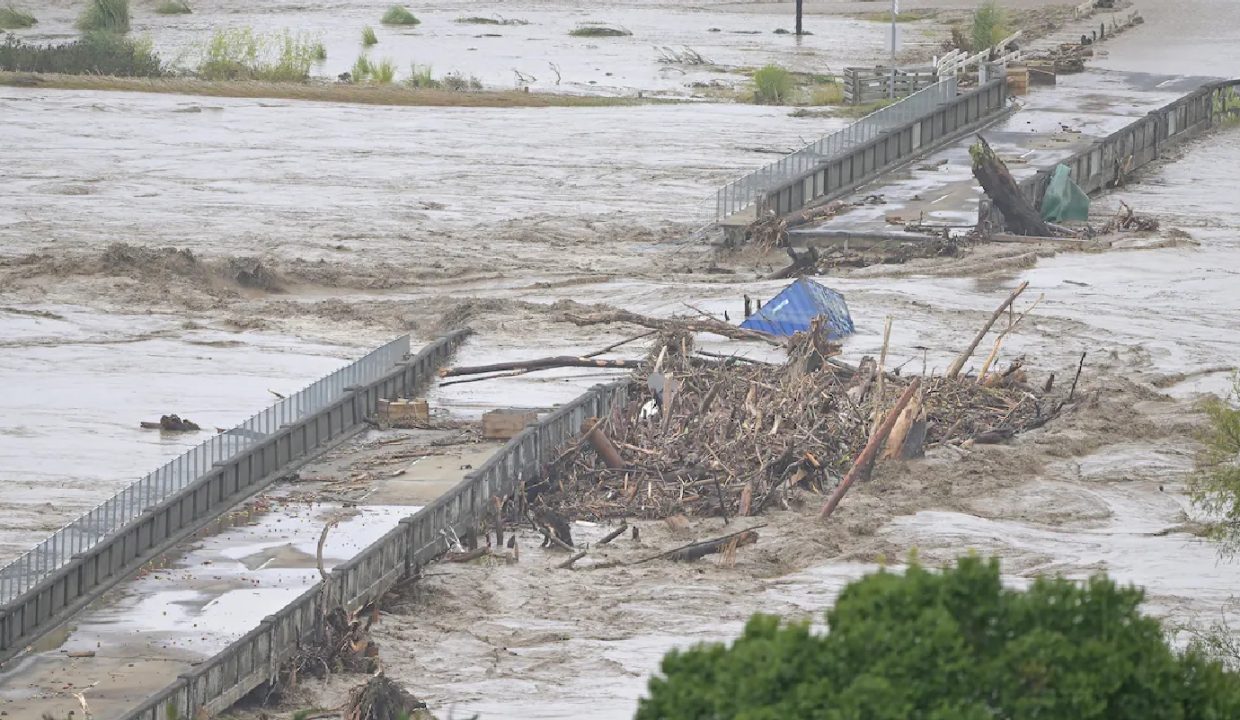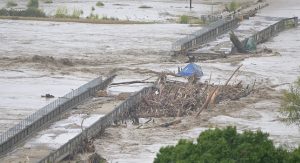
Climate extremes make NZ’s supply chains highly vulnerable
Supermarket customers around New Zealand are noticing gaps in the grocery aisles that have nothing to do with the global pandemic or Ukraine war. It is clear domestic food supply chains have been increasingly challenged by natural disasters and the ongoing impact of climate change.
Countdown recently warned customers that certain foods would be in short supply due to flooding on the East Coast. Time and again, we have seen such shortages and significant increases in the price of certain foods, particularly fresh produce.
The question is whether we have just been unlucky, or are these disruptions a result of deeper issues in the New Zealand food system? Are we more vulnerable than other countries, and if so, what does this mean for our food security?
Over the decades, New Zealand has centralised its food system and increased the risk that a single regional event could reverberate nationally. But it’s not too late to diversify and increase resilience across our food supply system.
● Efficiency over resiliency
Modern food supply chains have largely been optimised for economic efficiency rather than resilience to supply-side shocks.
The agricultural sector has seen a process of increasing scale and specialised production – primarily to increase profitability. In part, this has been driven by land suitability.
The outcome is a relatively small number of large-scale processing factories and the concentration of enterprises in specific regions. For example, around 32 percent of New Zealand’s horticultural products come from the Bay of Plenty and Hawke’s Bay.
At the retail end of the chain, large, centralised distribution centres and “just in time” delivery systems keep costs low for the two dominant supermarket chains, which account for between 80 percent and 90 percent of the food we consume. Food is brought to just a handful of distribution centres before being dispersed across their networks of stores.
But disruptions in one region can affect the entire country. In the aftermath of the Christchurch earthquake, the distribution centres serving the entire South Island were damaged. Supermarkets were forced to ship supplies from their North Island hubs.
A recent study from the Timaru District Council found that while South Canterbury describes itself as the food bowl of New Zealand, 95 percent of the commercially-bought food in the district comes from outside the region.
● Over-dependence on roads
The current supply chain model is totally reliant on the uninterrupted movement of products across the country through our transport network – in theory, comprised of road, rail, sea and air links.
In practice, just under 93 percent of freight goes by one mode – road. This compares with 72 percent in Germany.
Topography coupled with low population densities mean many regions are served by only one or, at most, two main roads suitable for freight trucks. We are nearly totally reliant on roads but our road networks are particularly vulnerable to climatic events and other natural disasters.
Our food distribution system seems to be better set up to get exports out or imports in through ports and airports than to move food around New Zealand. The vast majority of our agricultural products are exported rather than consumed in New Zealand.
● Resilience in uncertain times
All the evidence suggests climate change is going to increase the challenges in our food system, with more frequent and intense weather events. Projected sea-level rise will also put more strain on our already vulnerable food system at the farm and processing levels, as well as our ability to move it around the country.
Regional councils are clearly concerned, and there is increasing discussion of the concepts of food resilience and local food networks.
But what does a food system designed around resilience rather than optimisation look like? Does it simply mean less choice and higher prices? Or can it tackle other challenges, such as diet and health, environmental concerns and broader food security?
Two possible and compatible paths are evident. The first relates to local food networks and involves diversification of the products produced within each region, at both the farm and processing and manufacturing levels.
The idea of distributed manufacturing – basically mini-factories dispersed through the country – has been discussed in the forestry sector in New Zealand but could equally be considered for food.
Some emerging technologies that reduce dependence on the local climate for production, such as vertical farming, could be important in local food networks. Aquaponics (farming both fish and plants together), or algae production in ponds, could also diversify local food resources.
The idea of “circularity” could help reduce dependence on external inputs. Food waste products, for example, could be turned into energy as well as fertiliser.
● From supply chains to systems
Alternatively, we could keep the potential benefits of national scale production, but invest to reduce the vulnerabilities in our transport networks. As recent research highlights, there could be multiple benefits to reducing reliance on roads.
And we don’t need to reinvent the wheel. Only 6 percent of freight is transported by rail – this could be increased to diversify shipping options.
There may also be opportunities to make more out of coastal shipping routes. At the moment, this largely comprises the movement of bulk products such as fertiliser and cement.
However we tackle the increasing vulnerabilities in our food supply chain, we need to think of it as a food system and not simply a supply chain. The complex interactions in our food system mean changes to one part are likely to have wider economic, environmental, social and cultural impacts.
Tackling our potential vulnerability to climate change needs to be undertaken in the context of a wider strategy for the entire food system.

기후 극단적 현상으로 인해 뉴질랜드의 식품 공급망 취약해져가고 있어
뉴질랜드의 국내 식품 공급망이 자연재해와 지속적인 기후 변화의 영향으로 점점 더 큰 어려움에 직면하고 있다. Countdown은 최근 동부 연안의 홍수로 인해 특정 식품들이 공급 부족으로 직면할 것임을 고객들에게 경고했다. 반복적으로 우리는 이러한 공급 부족과 특히 신선한 농산물의 가격 상승을 보고있다. 문제는 이것이 일시적인 자연현상 때문인지, 아니면 뉴질랜드 식품 시스템의 근본적인 문제로 인한 것인지의 여부이다. 우리가 다른 나라보다 더 취약한가, 그렇다면 이것이 우리의 식품 안보에 어떤 영향을 미치는 것인가? 수십 년 동안 뉴질랜드는 식품 시스템을 중앙집중화하고 하나의 지역적 사건이 전국적으로 파급될 수 있는 리스크를 증가시켰다. 하지만 식품 공급 시스템을 다변화하고 회복력을 강화할 수 있는 가능성은 아직 늦지 않았다.
● 회복력보다 효율성
현재 뉴질랜드 식품 공급망은 공급면 충격에 대한 회복력보다는 경제적 효율성에 초점을 맞추고 있다. 농업 부문은 수익성 증대를 위해 증대 규모와 특수화된 생산 과정을 가지고 있어 결과적으로 상대적으로 적은 수의 대규모 가공 공장들이 특정 지역에 집중되어 있는 상태이다. 예를 들어 뉴질랜드의 과수류 제품의 약 32 퍼센트가 베이 오브 플렌티와 호크스 베이에서 생산된다. 대규모 중앙 집중형 유통센터와 “적시에” 배송 시스템이 두 거대한 슈퍼마켓 체인을 위해 비용을 낮추고 있다. 이 두 체인은 우리가 소비하는 식품의 80퍼센트에서 90퍼센트 정도를 차지한다. 음식은 소수의 유통센터로 간 다음 그들의 매장 네트워크로 분산되어 판매된다. 하지만 한 지역의 혼란이 전국적으로 영향을 미칠 수 있다. 크라이스트처치 지진 이후, 전체 남섬을 서비스하는 유통 센터가 훼손되었다. 슈퍼마켓들은 북섬의 허브에서 공급품을 운송해야만 했다. 티마루 지역구는 최근의 연구에서 남부 칸터베리를 뉴질랜드의 식량 창고라고 설명하였지만, 지역 내에서 상업적으로 구입하는 식품의 95퍼센트는 지역 외부에서 온다는 사실을 밝혀냈다.
● 도로에 대한 과도한 의존
현재 공급망 모델은 원론적으로 도로, 철도, 해상, 항공으로 구성되어 있지만 뉴질랜드 전역은 완전히 도로망에 의존하고 있다. 실제로 약 93퍼센트의 화물이 도로를 통해 이동한다. 이는 독일의 72퍼센트와 비교되는 수치이다. 지형과 인구 밀도의 저조함으로 인해 많은 지역은 화물 트럭에 적합한 주요 도로 하나 또는 두 개로 서비스를 받는다. 뉴질랜드는 대부분의 지역이 도로에 완전히 의존하고 있지만, 도로망은 기후 이벤트와 기타 자연 재해에 특히 취약하다. 식품 유통 시스템은 뉴질랜드 내 식품을 움직이기보다는 수출하거나 수입하는 데에 더 적합한 것으로 나타났다. 뉴질랜드 농산물의 대부분은 국내 소비 대신 해외로 수출되고 있다.
● 불확실한 시기에 회복력
모든 증거들은 기후 변화가 더 빈번하고 강렬한 기상 이벤트를 가져올 것임을 시사한다. 예상되는 해수면 상승은 이미 취약한 농업 부문과 가공 단계, 그리고 나라 전역적으로 이동하는 운송에 더 큰 압력을 가할 것이다. 지방 자치 단체들은 이것을 분명히 우려하고 있으며, 식품 회복력과 지역 식품 네트워크에 대한 논의가 늘어나고 있다. 그러나 회복력을 중심으로 설계된 식품 시스템은 어떤 모습일까? 그것은 단순히 덜 다양한 선택과 높은 가격만을 의미하는 것인가? 아니면 식습관과 건강, 환경 문제 및 보다 넓은 식품 안보 문제도 대처할 수 있는가? 첫 번째는 지역 식품 네트워크와 관련이 있으며, 각 지역에서 생산되는 제품의 다변화와 농장, 가공 및 제조 수준에서 이루어진다. 국내 분산 제조 개념 – 국내에 흩어진 소규모 공장 -은 뉴질랜드의 산림 부문에서 논의되었지만 식품 분야에도 적용될 수 있다. 생산에 대한 지역 기후의 의존도를 줄이는 몇 가지 신흥 기술들은 지역 식품 네트워크에 중요한 역할을 할 수 있다. 수직 농장과 같이 지역 기후에 의존도를 줄이는 몇 가지 신흥 기술들이 지역 식품 자원의 다양성을 확대시킬 수 을 것이다. 양식과 식물을 함께 가꾸는 수경식 농업, 또는 연못에서의 조류 생산 등도 지역 식품 자원을 다양화시킬 수 있다. “순환성” 개념은 외부 자원 의존도를 줄이는 데에 도움이 될 수 있다. 예를 들어, 음식 폐기물은 에너지와 비료로 변환될 수 있다.
● 공급망에서 시스템으로
또는 뉴질랜드는 국가 규모의 생산에서 잠재적인 이익을 유지하되, 도로 의존을 줄이고 다른 종류의 운송시스템에 투자해야 한다는 의견도 있다. 현재 화물의 단 6퍼센트만 철도를 통해 운송되고 있는데 철도를 활용한 운송을 더 늘려야 할 수 있다. 또한 배를 통한 해로를 더욱 활용할 수도 있을 것이다. 현재 이는 주로 비료와 시멘트와 같은 대규모 생산품을 이동시키는 데만 사용되고 있다. 뉴질랜드의 식품 공급망의 증가하는 취약성에 대처하는 방법은 그것을 단순히 공급망이 아니라 식품 시스템으로 생각해야 한다는 점이다. 식품 시스템 한 부분에 대한 변화가 보다 넓은 경제적, 환경적, 사회적, 문화적 영향을 미칠 수 있음을 의미하기 때문이다. 기후 변화에 대한 잠재적 취약성을 다루기 위해서는 전체 식품 시스템에 대한 보다 넓은 전략의 맥락에서 이를 수행해야 한다.
